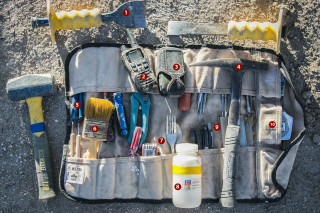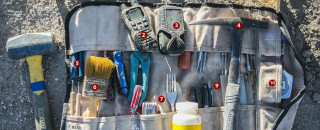Inside a Paleontologist's Field Kit
By Michael Mozdy
Our Paleontology Collections Manager, Carrie Levitt-Bussian, gave me full access to her field kit on a recent dig in Grand Staircase National Monument (read about the dig: Finding Fossils with the Pros in Grand Staircase). I gleefully photographed it, and what you see below is my annotated version of what paleontologists consider their most essential tools of the trade when in the field. Red circles and numbers have been added to help identify what’s in the field kit.

1. Chisels. Fossils are embedded in stone – yes, it’s sandstone and mudstone, but it can be as hard as concrete! So, in order to extract these dino bones, we need to break away the stone around it. We haven’t shown the big tools here, but note that jackhammers and rock saws are also tools of the trade, but don’t fit in a field kit. The chisels and hammer on left are used after the power tools make way for a workable quarry.
2. Walkie-talkie. Most paleo digs are in remote locations, and some of the team scout for potential sites (called prospecting) while the others stay to “work the quarry.” Walkie-talkies help us from getting lost and help us all get back to camp for chow time.
3. GPS. These handy devices also help us not get lost, but just as importantly, we document every site we find with GPS coordinates in field notebooks. Modern field work would be much, much harder without GPS devices guiding us to our sites.
4. Rock hammer. Carrie tells me that every paleontologist has a special relationship with his or her favorite rock hammer. The heft, the feel, the long hours accompanying you in the quarry…
5. More probes and chisels. From the larger blue chisel points to screwdriver-handled points to dental picks (center-right), we use varying sizes of points while hammering or tapping to move rock away from fossils. It’s proof of the old saying, “always choose the right tool for the right job.”
6. Brushes. Once you chip up a ton of debris and dust, brushes reveal what’s underneath. I found out they do a much better job than your fingers (which also run the risk of damaging the fossil). Note the much smaller brushes on the right, and reference #5 re: choosing the right tool.
7. Swiss army knife, fork and spoon. Sometimes you get hungry! While the utensils may not be in every paleontologist’s kit, Carrie assures me she’s used them: "You need the right tools for the job, even for just eating lunch. If you don’t, you might have to eat your leftover spaghetti with your fingers!"
8. Vinac. This is a consolidant - a solution of tiny vinyl beads and acetone, and it’s fairly thin with a water-like consistency between 5-15% solution. It’s also an amazing help in the field. We try to unearth fossils as carefully as we can, but sometimes they crack and crumble in the field. We use the consolidant to stabilize the bone as best we can until we can get to back to the controlled environment of the Fossil Prep Lab. There, where we can put it together with the right adhesive. What’s nice is that the Vinac is easily removed by a non-harmful solvent back at the museum so that the fossils can be cleaned and reconstructed properly.
9. Markers and plastic baggies. Well, Vinac isn’t magic! Sometimes fossils emerge from the rock in pieces, and when they come from the same area or bone, we put them in plastic bags and mark them as descriptively as possible to understand where exactly they were positioned in relation to the other bones in the quarry. We document in our field notebook what the bags are and what quarry they’re from. These bags are taken back to the museum with the other bones to be fully cleaned, repaired, and reconstructed in the Paleo Lab.
10. Tape measure. Fossils need to be measured, as do other distances in the quarry. While we could sport these like construction workers on our belts, squirming around in an often-tight quarry means that we keep our tools in our kit and grab them when needed.
Interested in learning more about what happens to the fossils uncovered with these tools? Check out this video to see the next step in a fossil's journey to the Museum: The Paleo Prep Lab. Or, visit the Past Worlds Exhibition at NHMU to see some of our team's dinosaur discoveries on display!
Michael Mozdy is a Digital Science Writer for The Natural History Museum of Utah, a part of the University of Utah in Salt Lake City. Our mission is to illuminate the natural world and the place of humans within it. In addition to housing outstanding exhibits for the public, NHMU is a research museum. Learn more.




